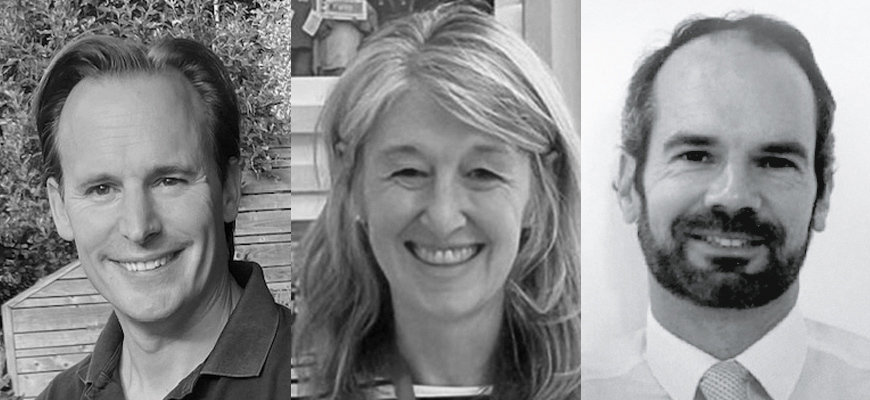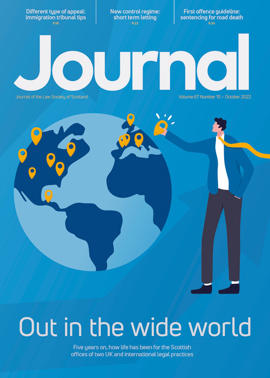In-house: How to become O shaped

Those of you who attended this year’s In-house Lawyers Annual Conference will have heard Gill Rust, data protection officer and deputy head of Legal & Risk at People’s Postcode Lottery, speak about her experiences of introducing the O Shaped programme to her team. Curious to find out more, I spoke to Gill, as well as to Neil Campbell, managing legal counsel in the Outsourcing, Technology & IP team at NatWest, and Greg Bargeton, who runs a legal and business consultancy called The Emerson Partnership, to learn about how we can all become more O shaped.
Before we begin, can you tell me a little about your background please?
GB: After spending 25 years practising law, mostly in-house in the drinks industry, I now run a legal consultancy. I get to work for interesting clients that inspire me, and contribute towards their success.
GR: I started my traineeship 30 years ago and I have worked all but my traineeship in-house, including 20 years at Standard Life (now known as Abrdn), and The Chartered Banker Institute, before moving to People’s Postcode Lottery (“PPL”).
NC: I am a technology lawyer at NatWest. Before joining NatWest 15 years ago, I had a variety of roles in both private practice and in-house, in the UK and in Australia, working in various sectors including energy, telecoms and financial services.
What is the O Shaped Lawyer and how did it come about?
NC: The purpose of the O Shape is to make the legal profession better – for those who are in it, those using it and those who are entering it. Dan Kayne, former GC at Network Rail, founded the O Shaped Lawyer, because he believed the legal profession has for too long focused on technical legal skills at the expense of a more rounded development. Dan recognised there is a gap between the technical legal skills that we gain from university and training, and the more human-centric skills which are necessary to do our jobs well. Dan, along with the O Shaped steering group, developed the 5 Os Framework which contains the five elements of the O Shaped mindset – a mindset for change (see graphic below).

How and why did you get involved in the O?
GB: Something is not quite right in the legal profession, particularly in how we measure success and what we think a “good” lawyer is. The O Shape is a platform that speaks about things that I’d thought about but had not been able to articulate quite as well. The platform gives people the opportunity to explore the gaps, opportunities and challenges and go on a journey of development.
NC: I have been interested since it kicked off in 2019 and I’m now part of the O Shaped Steering Group. The common denominator of the group is that they really care about the profession. We recognise lawyers need more than technical legal competence. For example, if you are line managing people, you need the skills to lead and develop people. So many of us have had to develop these skills through trial and error, and to me the O Shaped Lawyer is designed to do something about that.
GR: An article on LinkedIn that Dan Kayne had put up caught my eye. The Legal & Risk team at PPL were looking for something to help develop soft skills and improve our ability to work better with our business. So I got in touch with Dan and we started developing a programme specifically for our team at PPL.
Why do you feel the O Shaped Lawyer is necessary?
GB: There are two sides to this. One is a pessimistic view – we’re probably all doomed if we carry on the way we are. Change is needed within the profession. There is a lot of legal tech now that can deliver the technical expertise that we have in our heads more efficiently and cheaply. We need to react to where the modern profession is.
More optimistically, we are just not tapping into the true potential of people in the profession. There is a huge amount to be done to get the best out of people so that our clients get the best. We need to deliver a more rounded service, because when you can collaborate with clients on a broader level you get unbelievable results and a real sense of value added beyond technical knowledge and expertise.
Who is the O Shaped Lawyer relevant to?
GR: Everyone! Within our Legal & Risk team, everyone, not just the legal professionals, went through the programme because everyone in our team can learn from this. If we can build better relationships within PPL and show how we are creating value, we can work together on matters so that we get the best solution for everyone. It’s about saying this is how we can work with law and regulations that govern what we do, to ensure we can deliver something that works for the business.
What is the O Shaped Lawyer programme doing?
NC: The 5 Os framework was followed by the 12 O Shaped attributes. These represent the competencies of an O Shaped lawyer and are centred round three pillars: building relationships, creating value and being adaptable (see below). We have being raising awareness of the message and have created a forum for all parts of the legal system (in-house, law firms, students, legal educators, etc) to come together and discuss how can we change the profession, as no one group can make that change on its own.

There are two distinct workstreams. One is the education workstream, where we work with universities and law schools to help shape the future of legal education. The other is the practice workstream, which works with in-house teams and law firms to understand the needs of the profession and to demonstrate how powerful the O Shaped attributes are in real-world relationships. There is a very practical side too, because it has created a forum of O Shaped champions who have come together and are sharing their experiences, which in turn is leading to some very interesting materials coming out. For example, we are looking at developing materials for including the O Shape in legal tenders and materials to help identify and recruit more O Shaped personnel.
The O Shaped Lawyer talks about “People First” – what does this mean?
GB: It means different things to different people. But for me, lawyering is all about relationships. You can have all the technical skills in the world, but without creativity, without empathy, without a mindset that leads towards collaboration, you won’t make the value added contribution. The O Shape puts legal practice into a much broader context and brings to the fore this range of skills that can hopefully result in a more impactful contribution.
How have you used the O Shaped Lawyer to help your team? How has your wider organisation benefited?
GR: The O Shaped Lawyer delivered bespoke workshops for PPL and then we set ourselves goals based on what we had learned. As a young company with a fairly recent in-house legal team, we used the O Shaped programme to get to know not just the business, but also ourselves. It has helped the business understand the importance of having a Legal & Risk team, and helped change the mindset within the team.
For the “creating value” attribute, we sought to increase board awareness. We want the board to understand that when we’re invested, it helps create success and we are enablers. By getting us involved at the start of a process, it helps speed the process up. In addition, we have set ourselves the task of looking for opportunities. For example, PPL recently increased their marketing, which in turn led to an increase in deletion requests. So we established a cross-departmental project to review proactively our process for handling deletion requests. This resulted in PPL’s ability to respond to requesters within 24 hours, instead of the previous average of 20 days. Interestingly, our own team, Legal & Risk, did not really benefit from the reduction in times but our colleagues did, and so by applying our O Shaped values we’ve done something that’s improved the lives of other teams.
The emotional intelligence element of the O Shaped programme gives us a skillset to be able to build relationships internally, helping us to become more trusted advisers. By taking the time to focus on those skills, it has made us feel more empowered to start building those relationships and put all of that work into practice.
The important thing to remember is that this is a continuous improvement piece – we are not sitting and resting on our laurels. We regularly review and update our goals and add new goals as appropriate.
How have you used the O Shaped Lawyer to help develop your relationship with law firms?
NC: Our team was involved with an O Shaped Lawyer pilot with a law firm and it enabled us to work through the attributes and unpack the relationship; to have an honest conversation and build the relationship and trust up again. We really wanted our external lawyers to be an extension of our team, and through the O Shaped sessions, we are now closer, enabling us to have more honest dialogue and give better feedback. It also encourages us to share information with one another beyond technical expertise, e.g. understanding legal technology tools. Of course, we need to keep feeding the relationship and keep communication going to maintain this.
How can I get involved?
GR: We got involved by reaching out to the founder to express interest in the programme.
GB: Me too. Even if you don’t have time to contribute to any of the workstreams, if the good material that is out there resonates with you, which I think it will with a lot of people, then just spread the word!
NC: I agree. You can take the O Shaped approach back to your team and discuss whether there is anything from it that you can apply to improve yourself and the team. We also have an O Shaped Future Board which is made up of students, trainees and junior lawyers and which is active on social media.
They have lots of ideas and it is worth linking up with them. If people are very keen, they can become an O Shaped champion, join the discussion and support various initiatives that are going on.
Find out more
If you would like to find out more about the work of the O Shaped Lawyer and how you can get involved, visit their website: www.oshapedlawyer.com or join their LinkedIn group.
Regulars
Perspectives
Features
Briefings
- Criminal court: Dealing with delay
- Criminal court: Justiciary Office briefing
- Licensing: The murky world of insolvency
- Insolvency: AiB’s powers under review again
- Tax: A “mini-budget” with big changes
- Immigration: Scaling up for growth
- Scottish Solicitors' Discipline Tribunal
- Property: New homes codes: setting the record straight
- Property: In Scots law, what makes a contract a lease?
- In-house: How to become O shaped






